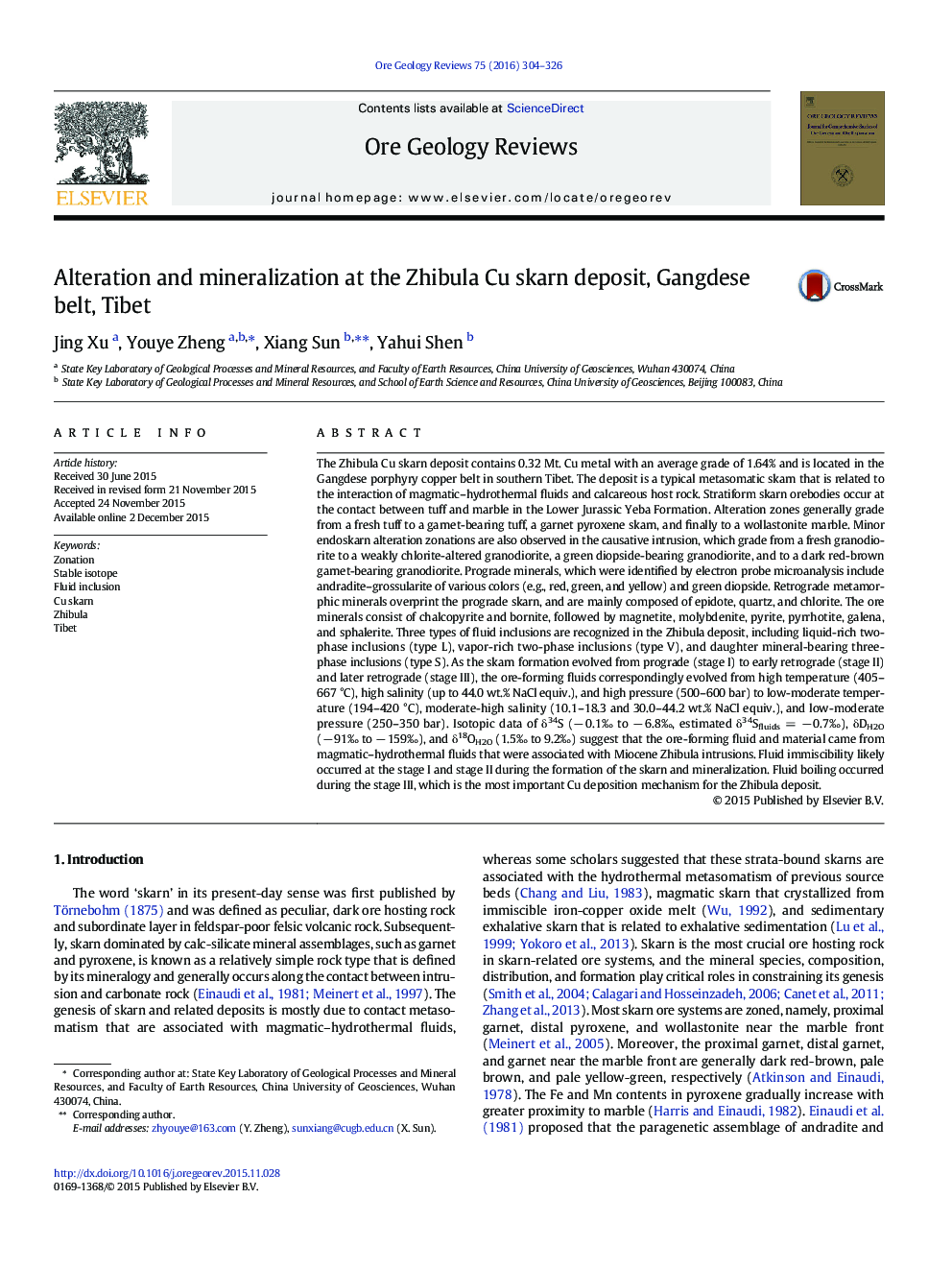| کد مقاله | کد نشریه | سال انتشار | مقاله انگلیسی | نسخه تمام متن |
|---|---|---|---|---|
| 4696908 | 1637231 | 2016 | 23 صفحه PDF | دانلود رایگان |

• Both endoskarn and exoskarn occurred as zonations.
• Fluid inclusions display high temperature and high salinity.
• Sulfur, hydrogen, and oxygen studies indicate that fluid was magmatic water.
• Fluid boiling is the crucial mechanism for Cu precipitation.
The Zhibula Cu skarn deposit contains 0.32 Mt. Cu metal with an average grade of 1.64% and is located in the Gangdese porphyry copper belt in southern Tibet. The deposit is a typical metasomatic skarn that is related to the interaction of magmatic–hydrothermal fluids and calcareous host rock. Stratiform skarn orebodies occur at the contact between tuff and marble in the Lower Jurassic Yeba Formation. Alteration zones generally grade from a fresh tuff to a garnet-bearing tuff, a garnet pyroxene skarn, and finally to a wollastonite marble. Minor endoskarn alteration zonations are also observed in the causative intrusion, which grade from a fresh granodiorite to a weakly chlorite-altered granodiorite, a green diopside-bearing granodiorite, and to a dark red-brown garnet-bearing granodiorite. Prograde minerals, which were identified by electron probe microanalysis include andradite–grossularite of various colors (e.g., red, green, and yellow) and green diopside. Retrograde metamorphic minerals overprint the prograde skarn, and are mainly composed of epidote, quartz, and chlorite. The ore minerals consist of chalcopyrite and bornite, followed by magnetite, molybdenite, pyrite, pyrrhotite, galena, and sphalerite. Three types of fluid inclusions are recognized in the Zhibula deposit, including liquid-rich two-phase inclusions (type L), vapor-rich two-phase inclusions (type V), and daughter mineral-bearing three-phase inclusions (type S). As the skarn formation evolved from prograde (stage I) to early retrograde (stage II) and later retrograde (stage III), the ore-forming fluids correspondingly evolved from high temperature (405–667 °C), high salinity (up to 44.0 wt.% NaCl equiv.), and high pressure (500–600 bar) to low-moderate temperature (194–420 °C), moderate-high salinity (10.1–18.3 and 30.0–44.2 wt.% NaCl equiv.), and low-moderate pressure (250–350 bar). Isotopic data of δ34S (− 0.1‰ to − 6.8‰, estimated δ34Sfluids = − 0.7‰), δDH2O (− 91‰ to − 159‰), and δ18OH2O (1.5‰ to 9.2‰) suggest that the ore-forming fluid and material came from magmatic–hydrothermal fluids that were associated with Miocene Zhibula intrusions. Fluid immiscibility likely occurred at the stage I and stage II during the formation of the skarn and mineralization. Fluid boiling occurred during the stage III, which is the most important Cu deposition mechanism for the Zhibula deposit.
Figure optionsDownload as PowerPoint slide
Journal: Ore Geology Reviews - Volume 75, June 2016, Pages 304–326